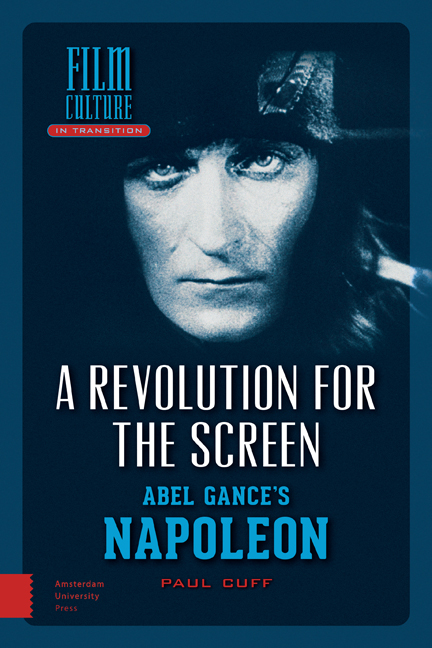Book contents
- Frontmatter
- Dedication
- Contents
- List of Illustrations
- Note on Formatting
- Acknowledgements
- Foreword
- Preface: Critical perspective
- 1 Napoleonic Ambition and Historical Imagination
- 2 Shaping Expectations: The Young Napoléon Bonaparte
- 3 Civilization and Savagery: Visions of the French Revolution
- 4 Mortal Gods: Voices of Power and of Providence
- 5 The Dark Light of Napoleonic Cinema
- 6 A View from the Margins of History
- 7 Melodrama and the Formulations of Family
- 8 Worlds in Transition: Class, consumption, Corruption
- 9 Death and Transfiguration
- Conclusion: The Case for Enthusiasm
- Filmography and Bibliography
- Index
- Film Culture in Transition
2 - Shaping Expectations: The Young Napoléon Bonaparte
Published online by Cambridge University Press: 10 December 2020
- Frontmatter
- Dedication
- Contents
- List of Illustrations
- Note on Formatting
- Acknowledgements
- Foreword
- Preface: Critical perspective
- 1 Napoleonic Ambition and Historical Imagination
- 2 Shaping Expectations: The Young Napoléon Bonaparte
- 3 Civilization and Savagery: Visions of the French Revolution
- 4 Mortal Gods: Voices of Power and of Providence
- 5 The Dark Light of Napoleonic Cinema
- 6 A View from the Margins of History
- 7 Melodrama and the Formulations of Family
- 8 Worlds in Transition: Class, consumption, Corruption
- 9 Death and Transfiguration
- Conclusion: The Case for Enthusiasm
- Filmography and Bibliography
- Index
- Film Culture in Transition
Summary
The man is revealed in his childhood, if one is prepared to judge men by the passion betrayed in their glance, and not by the docility they show on their benches at school. Napoléon appeared in his savage pride, a sign of the greatness which already marked him as a child; equally, he took the lead in any game – the role of chief, his clothes torn, his mouth bloody; or, his loneliness and silence in the midst of laughter and noise. Beaten until he bled, he never cries out or weeps. Innocent, he never speaks up. He is bullied, he is abused, he keeps his teeth clenched (Faure 1921: 35).
Introduction
My chronological survey of NAPOLÉON begins with the opening scenes, set during Bonaparte's boyhood days at Brienne College. This was a military academy the child had joined in early 1779, having been sent by his parents to the mainland from the island of Corsica at the age of nine. Gance's scenes are set in 1783, the year before Bonaparte left Brienne for the Ecole Militaire in Paris. This prologue establishes a number of aesthetic and narrative ideas that are developed over the course of the film. After examining the intellectual impetus behind the cinematic techniques visible in these scenes, I will explore how Gance's visual language and manipulation of historical evidence produces an engaging characterization of the young Bonaparte (Nicolas Roudenko). I aim to highlight the ways in which dramatic irony creates both objective distance to, and subjective involvement with, this central figure – and the effects of this ambiguity on our understanding of character and narrative. Far from offering a ‘banal’ (Thomson 1994: 273) or ‘psychologically simplistic’ (Andrew 1999: 44) portrait, Gance produces a complex interpretive experience for audiences.
Cinema as experiential art
Gance's filmmaking techniques in NAPOLÉON must be understood in conjunction with the nature of the cinematic experience in the silent era. Between the late nineteenth century and the universal adoption of sound in the 1930s, live performance was standard practice in film venues. The type of accompaniment varied hugely, both in scale and in quality: bands and orchestras, soloists and singers, narrators and showmen all featured in the 1900s.
- Type
- Chapter
- Information
- A Revolution for the ScreenAbel Gance's Napoleon, pp. 55 - 78Publisher: Amsterdam University PressPrint publication year: 2015



